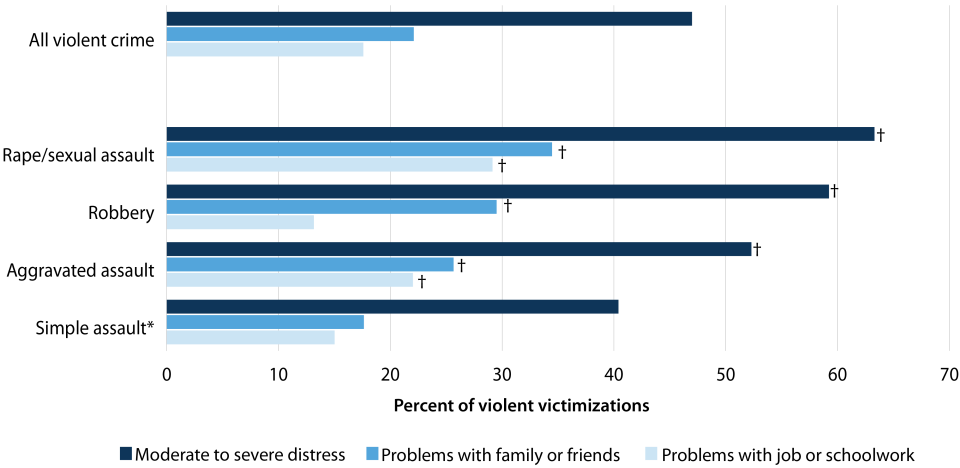Emilie Coen, DrPH, and Alexandra Thompson
BJS Statisticians
Download PDF (445K)
August 2024, NCJ 309041
Violent victimization is known to have consequences on victims’ lives, including negatively impacting their social and emotional well-being. (See Socio-Emotional Impact of Violent Crime, NCJ 247076, BJS, September 2014.) In the National Crime Victimization Survey, socio-emotional consequences of crime include moderate to severe emotional distress, significant problems with friends or family, and significant problems with one's job or schoolwork. Victimizations reflect the total number of times that persons were victims of crime.
Key Findings
In 2022:
- Nearly half of all violent victimizations (47%) resulted in moderate to severe distress to the victim (figure 1). About 22% of violent victimizations resulted in the victim experiencing significant problems with family or friends, and 18% caused significant problems with their job or schoolwork.
- More than half of rape or sexual assault (63%), robbery (59%), and aggravated assault (52%) victimizations resulted in moderate to severe distress to the victim, compared to less than half of simple assault (40%) victimizations.
- The victim reported significant problems with family or friends following 18% of simple assault victimizations, which was lower than the percentages for rape or sexual assault (34%), robbery (30%), and aggravated assault victimizations (26%).
- The victim reported significant problems with their job or schoolwork after 13% of robbery victimizations and 15% of simple assault victimizations, both lower than the percentages reported after rape or sexual assault (29%) and aggravated assault (22%) victimizations.
Figure 1. Percent of violent victimizations where the victim reported experiencing a socio-emotional consequence, by type of crime, 2022
Note: In the National Crime Victimization Survey, violent victimization includes rape or sexual assault, robbery, aggravated assault, and simple assault. A violent victimization may result in a victim reporting one or more of the following socio-emotional consequences: moderate to severe distress, significant problems with family or friends, or significant problems with their job or schoolwork. See appendix table 1 for estimates and standard errors.
*Comparison group.
†Difference with comparison group is significant at the 95% confidence level.
Source: Bureau of Justice Statistics, National Crime Victimization Survey, 2022.
Download CSV (2K)
Methodology
The data used to produce the statistical estimates in this report are from the 2022 National Crime Victimization Survey (NCVS), the nation's primary source of information on criminal victimization occurring in the United States. Data are obtained annually from a nationally representative sample of U.S. households, and persons age 12 or older are interviewed on the frequency, characteristics, and consequences of criminal victimization. For more information on the NCVS, see the Methodology section in Criminal Victimization, 2022 (NCJ 307089, BJS, September 2023).
For this report, three NCVS questions were used as a measure of socio-emotional consequences. Experiencing a socio-emotional consequence was defined as a victim reporting one or more of the following: feelings of moderate to severe distress; significant problems with their job or schoolwork, such as trouble with a boss, coworkers, or peers; or significant problems with family members or friends, including more arguments than before the victimization, an inability to trust, or not feeling as close after the victimization. For specific question wording, please see the 2022 NCVS Crime Incident Report questionnaire. Data used, including data documentation, are archived at the National Archive of Criminal Justice Data and are available for public use. More information on downloading the NCVS public use data in this report can be found here.
Moderate to severe | Problems with family | Problems with job | ||||
Type of crime | Percent | Standard error | Percent | Standard error | Percent | Standard error |
All violent crime | 47.0% | 1.99% | 22.1% | 1.54% | 17.6% | 1.38% |
Rape/sexual assault | 63.3† | 5.12 | 34.5† | 4.91 | 29.1† | 4.65 |
Robbery | 59.2† | 4.66 | 29.5† | 4.17 | 13.2 | 2.97 |
Aggravated assault | 52.3† | 3.42 | 25.7† | 2.86 | 22.0† | 2.68 |
Simple assault* | 40.4 | 2.33 | 17.6 | 1.69 | 15.0 | 1.56 |
Note: In the National Crime Victimization Survey, violent victimization includes rape or sexual assault, robbery, aggravated assault, and simple assault. A violent victimization may result in a victim reporting one or more of the following socio-emotional consequences: moderate to severe distress, significant problems with family or friends, or significant problems with their job or schoolwork.
*Comparison group.
†Difference with comparison group is significant at the 95% confidence level.
Source: Bureau of Justice Statistics, National Crime Victimization Survey, 2022.
Download CSV (2K)
The Bureau of Justice Statistics of the U.S. Department of Justice is the principal federal agency responsible for measuring crime, criminal victimization, criminal offenders, victims of crime, correlates of crime, and the operation of criminal and civil justice systems at the federal, state, tribal, and local levels. BJS collects, analyzes, and disseminates reliable statistics on crime and justice systems in the United States, supports improvements to state and local criminal justice information systems, and participates with national and international organizations to develop and recommend national standards for justice statistics. Kevin M. Scott, PhD, is the acting director.
This report was written by Emilie Coen, DrPH, and Alexandra Thompson. Erika Harrell, PhD, verified the report.
Eric Hendrixson edited the report. Jeffrey Link and Vesela Kostadinova produced this report.
August 2024, NCJ 309041



